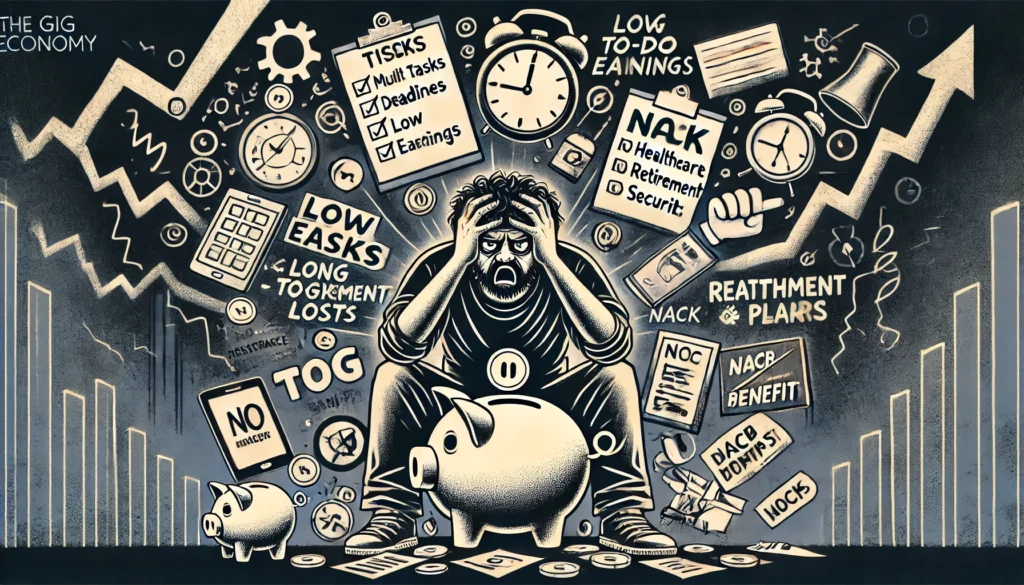Gig economy: खुद के मालिक या मजबूर?

Breaking News:
आधार कार्ड से मोबाइल नंबर कैसे लिंक करें? (Step by Step गाइड) | 2025
इंडियन प्रीमियर लीग (IPL) 2025: भारत-पाकिस्तान तनाव के चलते टूर्नामेंट अनिश्चितकाल के लिए स्थगित
बलूचिस्तान में बड़ा उथल-पुथल: बलूच विद्रोहियों ने क्वेटा पर कब्जा किया, पाकिस्तानी सेना को बाहर किया
पाकिस्तान में सेना प्रमुख Asim Munir की गिरफ्तारी: भारत-पाक तनाव के बीच बड़ा राजनीतिक भूचाल
Kathmandu Nepal
Saturday, Nov 29, 2025

कल्पना कीजिए एक ऐसी नौकरी का जहां आप अपने मालिक हैं, आप कब तक काम करना चाहते हैं ये आपको फैसला करना है। एक सपने जैसा लग रहा है, सही कहा ना?
Gig economy यह एक ऐसा कॉन्सेप्ट है, जो पूरे भारत में काफी जोरो सोरो से बढ़ रहा है, जहां आप को अदाजी के साथ और कोई भी वक्त काम करने की छूट देता है, लेकिन क्या यह आजादी एक दिखावा है जो Gig Workers का शोषण को छुपा रहा है?
आइए इस ब्लॉग में जानते हैं कि क्या है Gig economy, ऐसे वादे और छुपे हुए नुक्सान को गहराई से समझते हैं
हम जंग की रिसर्च करेंगे, भारतीय कानून क्या कहता है और भी बहुत कुछ, क्योंकि यह हमारे दैनिक जीवन पर प्रभाव डालता है।
गिग इकोनॉमी एक लेबर मार्केट है जहां लोग ऑन-डिमांड अपने काम, सर्विस या प्रोडक्ट को दे कर पैसा कमाते हैं, इसलिए इसे “शेयरिंग इकोनॉमी” या “एक्सेस इकोनॉमी” कहते हैं।
पारंपरिक full-time employment के बजाय, गिग अर्थव्यवस्था इस पर बहुत अधिक निर्भर करती है:
Temporary positions: बहुत कम समय है, फिर एक प्रोजेक्ट के लिए रोजगार।
Part-time positions: Part-time employees full-time employment की तुलना में कम काम करते हैं।
Independent contractors: इनको specific task करने के लिए बुलाया जाता है
Freelancers: ये अपनी सर्विस मल्टीपल क्लाइंट को प्रोजेक्ट के आधार पर।
गिग इकोनॉमी में लोग 9 से 5 की जगह ऑन डिमांड अपने काम को करते हैं, अक्सर ये काम ऐप या वेबसाइट के माध्यम से किया जाता है
Gig work ke kuch example:
Gig economy श्रमिकों और व्यवसायों दोनों के लिए विभिन्न लाभ लाती है, जिन्हें मोटे तौर पर निम्नानुसार वर्गीकृत किया जा सकता है:
इसके फायदों के बावजूद, gig economy कई चुनौतियाँ भी पेश करती है:

Although the Indian Constitution doesn’t explicitly mention gig workers, it guarantees:

Gig economy पारंपरिक कार्य संरचनाओं को नया आकार दे रही है, लचीलापन और आय के अवसर प्रदान कर रही है, जबकि श्रमिक सुरक्षा और सामाजिक सुरक्षा के बारे में चिंताएं बढ़ा रही है।
To ensure a sustainable gig economy, stakeholders must work together to:
इन चुनौतियों का समाधान करके, gig economy एक अधिक न्यायसंगत और टिकाऊ मॉडल के रूप में विकसित हो सकती है जो श्रमिकों और व्यवसायों को समान रूप से लाभान्वित करती है।
नई पीढ़ी के लिए मार्गदर्शक स्वामी विवेकानन्द जी के बारे में जानने के लिए हमारे इस लेख को अवश्य पढ़ें
Q1: What is the gig economy?
ANS: The gig economy refers to a labor market centered around temporary, flexible jobs, often facilitated by digital platforms. Instead of traditional full-time roles, gig workers take on short-term contracts or assignments for multiple clients.
Q2: What are some examples of gig work in India?
ANS: In India, common examples of gig work include:
Q3: What are the advantages of the gig economy for workers?
ANS: The gig economy offers several benefits for workers, including:
Q4: What are the disadvantages of the gig economy for workers?
ANS: Despite its benefits, gig work comes with challenges such as:
Q5: Is there any law for gig workers in India?
ANS: India does not currently have a specific law dedicated solely to gig workers. However, the Code on Social Security, 2020, includes provisions for gig and platform workers, making them eligible for benefits like:
Q6: What does the Indian Constitution say about gig workers?
Although the Indian Constitution does not explicitly mention gig workers, it guarantees fundamental rights that can be applied to them:
Q7: What are the future trends of gig work in India?
ANS: The gig economy in India is expected to grow rapidly, with:
Q8: How can the lives of gig workers be improved?
ANS: Improving the conditions for gig workers involves:
मुझे उम्मीद है कि आप लोगों को गिग इकोनॉमी में लिखा यह आर्टिकल अच्छा लगा होगा, आप अपने विचार comment के माध्यम से हम तक भेज सकते हैं धन्यवाद
One Reply to “Gig economy: खुद के मालिक या मजबूर? ”